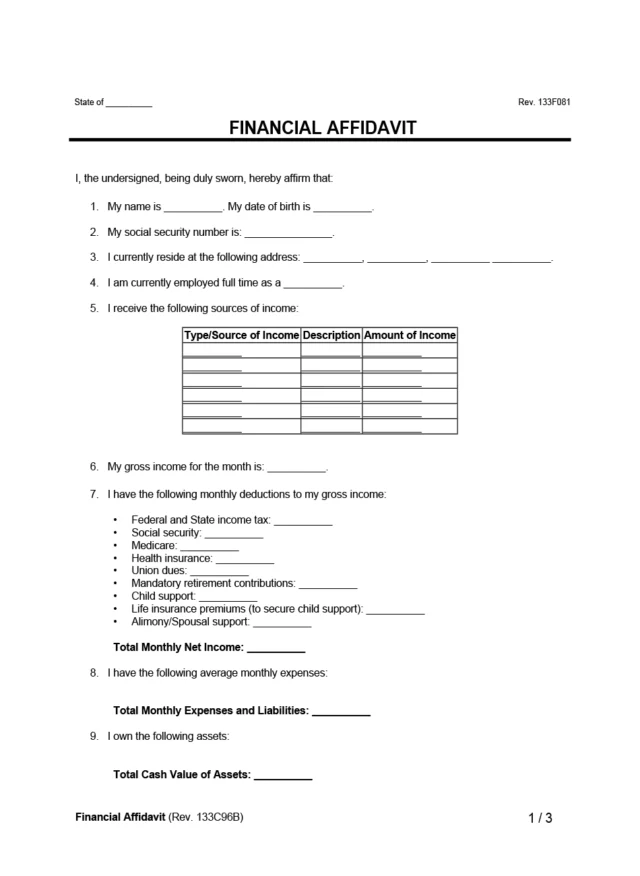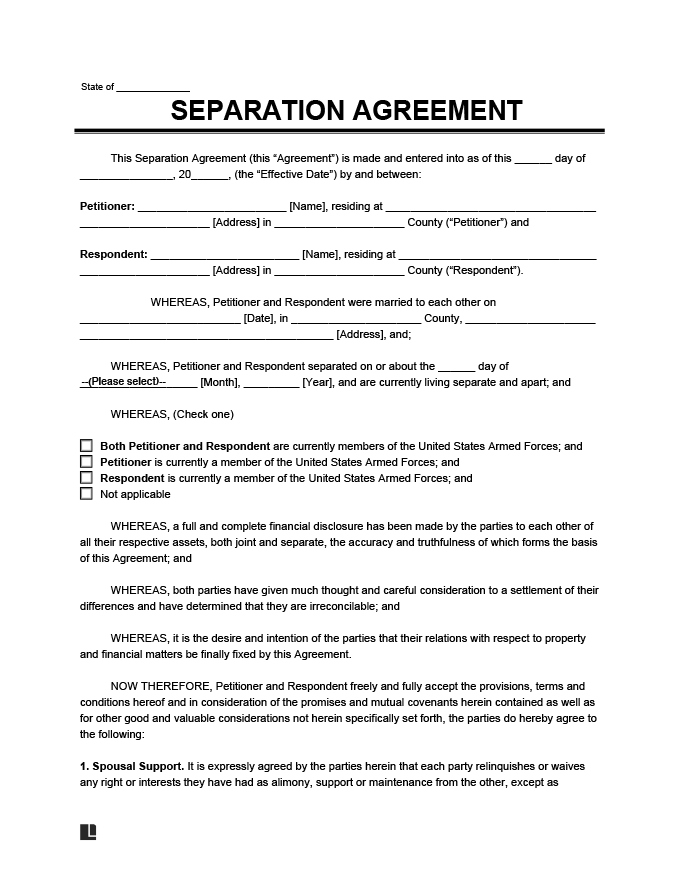What Is a Separation Agreement?
A separation agreement is a legally binding document created by a married couple who have decided to live apart but are not yet ready to file for divorce. It outlines how they will handle key matters such as property division, child custody, spousal support, and living arrangements during the separation period.
In some states, you must file the agreement with the court for it to be enforceable. In others, simply signing and notarizing the document is enough to make it legally binding. Be sure to check your state’s rules to understand what applies to your situation.
This agreement allows the couple to remain legally married while clearly documenting their responsibilities. This can help preserve certain legal benefits, such as shared health insurance or tax advantages.
You may want to use a separation agreement if:
- You and your spouse want to live apart while deciding if divorce is the right choice
- You need to divide assets, debts, or parenting responsibilities clearly
- You want to avoid future disagreements by putting everything in writing
Learn more about the differences between legal separation and divorce.
How to Write a Separation Agreement
A clear separation agreement helps avoid confusion later. Follow these steps to outline your terms, or use our online template to save time and cover everything you need.
Step 1 – Fill in Basic Information
Start by including basic details about the relationship and each partner:
- Full legal names and addresses of both spouses
- Date and location of the marriage
- Date of separation
- Whether either party is or was in the military
Step 2 – Decide on Spousal Support
Decide whether either party will receive financial support (also called alimony or maintenance). If yes, include:
- Payment amount and frequency
- Start and end dates
- Whether support will be terminated upon the remarriage or cohabitation of the receiving spouse
- Whether support can be changed later
- If a life insurance policy will be used to guarantee payments (optional)
Step 3 – Divide Real Estate (If Applicable)
Clarify what will happen to the marital home and any other property:
- Will one person keep the home?
- Will it be sold or leased, and how will profits be split?
- Who is responsible for the mortgage, taxes, and repairs?
- If the debt must be refinanced or assumed by the spouse remaining in the home
- Include the address and value of each property
If one spouse wants to keep the home, you can agree to a house buyout, where that spouse pays the other for their share of the home’s equity. The buyout amount is usually based on the home’s current market value minus any remaining mortgage. It can be paid using savings, a new loan, or by refinancing the mortgage.
Learn how a divorce house buyout works, including calculating equity, funding the buyout, and finalizing ownership through refinancing or asset exchange.
Step 4 – Allocate Bank and Financial Accounts
List all joint and separate accounts (checking, savings, investment), and specify:
- Who will keep each account
- Whether any funds will be transferred or split
- How will ongoing account access be managed
Step 5 – Assign Personal Property
Make a plan for dividing personal belongings such as:
- Furniture, electronics, appliances, pets and valuables
- Collections, jewelry, and other high-value items
You can also attach an itemized inventory (as an exhibit) to avoid confusion later.
If you have a prenuptial agreement, review it before finalizing your separation terms to ensure there’s no conflict.
Step 6 – Divide Vehicles
Include all vehicles owned by either party, including:
- Year, make, and model of each vehicle
- Who will keep the vehicle
- Who will handle any remaining loan payments, insurance, and registration
Step 7 – Address Debts and Liabilities
Determine how you’ll divide shared debts, such as:
- Credit cards
- Loans
- Medical bills
- Other outstanding obligations
List the creditors, amounts owed, and who is responsible for each debt.
Step 8 – Handle Retirement Accounts
Retirement savings may be part of the marital estate. Decide whether any of the following will be split:
- 401(k), IRA, or pension plans
- Profit-sharing or investment accounts
Include percentages or dollar amounts and the names of the financial institutions holding the accounts.
Step 9 – Set Income Tax Responsibilities
Decide when you’ll start filing taxes separately and who will:
- Handle any tax refunds or liabilities from prior joint filings
- Claim dependents (if applicable)
- Pay taxes owed or due during the separation period
Step 10 – Name Change (Optional)
If either party wants to return to a previous legal name, include that request in this section. In many states, this may also be requested as part of the final divorce judgment.
Step 11 – Include Additional Legal Terms
You may want to include general legal protections to reduce future conflict. These are built into our template and typically include:
- Mutual release of future claims
- Confirmation that both parties fully disclosed financial information and that the agreement was signed willingly and voluntarily
- A clause explaining which state’s law governs the agreement
- A requirement to attempt mediation before going to court
- An option to file the agreement with the court (especially useful if required by your state)
- Whether legal fees will be awarded to the prevailing spouse in the event of a future violation of the agreement
You don’t always need to file your agreement with the court for it to be effective. However, filing it may help define your official separation date and can be helpful in divorce proceedings later.
Step 12 – Sign and Notarize
To finalize the agreement, both parties must sign the document. While signatures alone may be enough in some states, notarization adds legal strength and helps prevent future disputes.
Include the following:
- Signatures from both spouses
- Signature of one or more witnesses (recommended)
- Notary public acknowledgment
Once signed and notarized, your separation agreement becomes a legally enforceable contract. You can also choose to file it with the court, especially if your state requires a formal separation period before divorce.
Next step if you decide to divorce
If you and your spouse choose to move from separation to divorce later on, you can use a divorce agreement to formalize the final terms of your split.
Is a notarized separation agreement legally binding?
Yes. A signed and notarized agreement shows that both parties entered the contract voluntarily and understand its terms. While notarization is not always legally required, it strengthens your case if the agreement is challenged in court.
You should always check your state’s laws on notary acknowledgments to determine whether this is a required step to validate your agreement.
Separation Agreement Sample
Wondering what a separation agreement looks like? Here’s a template that you can customize with Legal Templates. Then, once it’s complete, you can download it in PDF or Word format.
Can a Legal Separation Agreement Be Changed?
Yes. If your circumstances change, such as income, living situation, or child care needs, either party can request modifications through the court, but both parties must agree on the changes. This process usually requires showing a valid reason for the change.
Can a Separation Agreement Be Overturned?
In rare cases, courts can overturn a separation agreement if:
- It was signed under duress or coercion
- One partner failed to disclose financial information
- The terms are extremely unfair, illegal, or violate public policy
To avoid these issues, both parties should disclose assets honestly and consider legal review before signing.
How Much Does a Separation Agreement Cost?
The cost of a separation agreement depends on how you create it and whether you need to involve the court.
In most cases, you can save money by creating a private separation agreement with your spouse, without hiring a lawyer or filing with the court. But if you’re pursuing a formal legal separation, court involvement may be required, which adds to the cost.
Here’s what you can expect:
- DIY separation agreement: Free to $150 (using an online template)
- Attorney-drafted agreement: $500 to $2,500+, depending on complexity/location
- Court filing fees (optional): $200 to $400+ (only if you file with the court)
You typically only pay court filing fees if you are filing for legal separation, which is a court-recognized status similar to divorce, but without ending the marriage.
Lowest-cost option
Creating your own agreement using an online separation agreement template like ours. This avoids court and legal fees and lets you manage the process on your own terms.
Do You Need a Lawyer for a Separation Agreement?
No. You are not legally required to hire a lawyer. Many couples create their own agreements, especially when they agree on the terms. However, if your situation is complex or if you’re unsure about your rights, getting legal advice can help.







